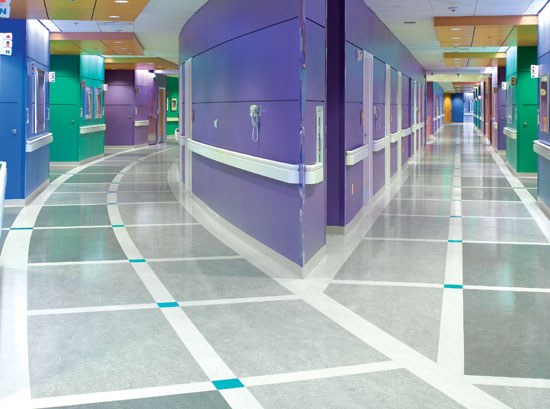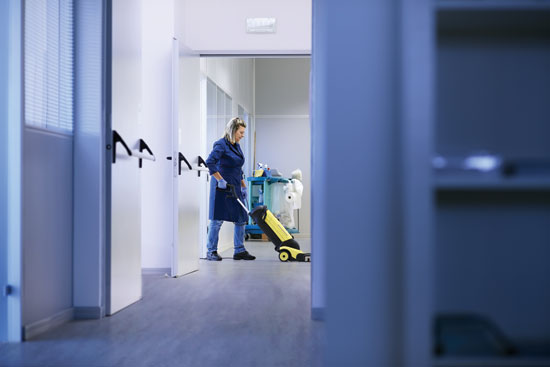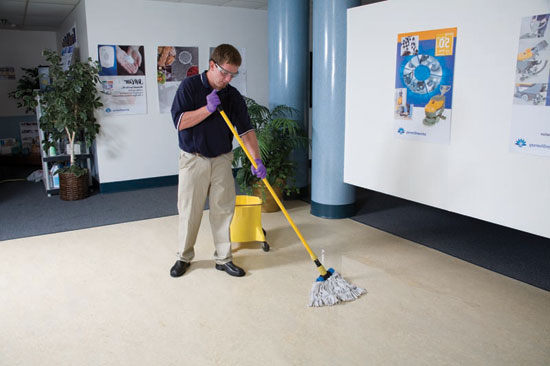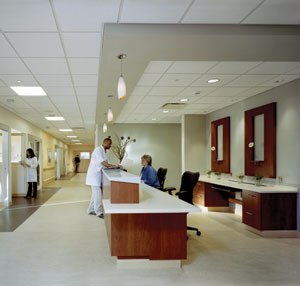Creating Healthy Healthcare Environments
In response to these serious concerns, healthcare professionals worldwide are becoming increasingly focused on creating environments that fulfill the fundamental tenet at the heart of every physician's Hippocratic Oath: Primum Non Nocere—first, do no harm. Architects and interior design professionals share in this focus in that we are obligated to protect the health, safety, and welfare of the public. While we also do not seek to do any harm to people, we have the means to find ways that improve the indoor environment to be truly healthier and safer, particularly to vulnerable populations such as hospital patients. Most architects and designers are already aware that indoor air is often contaminated with a complex mixture of chemicals from many sources, including emissions from building materials. Disease risks in people related to this polluted environment can include asthma, bronchitis, cancer, and reproductive, developmental, and neurological disorders. Hence it has become the norm to specify and design with building materials and products that avoid these emissions or contaminants in the interest of creating safer, cleaner indoor environments. We have the opportunity to act in a similar way regarding HAIs.

Photo by Brian Dressler Photography Inc.; courtesy of Forbo Flooring Systems
The Patewood Memorial Hospital in Greenville, South Carolina, used linoleum flooring that contributes to a positive life-cycle assessment for buildings.
Hospital administrators and staff have also taken on the quest to create safer indoor environments by using cleaning routines that include powerful new antibacterial compounds developed to fight off infectious bacteria. The good news is that healthcare workers are beginning to make progress against two of the best-known infectious bacteria namely MRSA and Clostridium difficile (C. difficile). Government data from Public Health England reported that better control of MRSA and C. difficile led to a nationwide decrease in the prevalence of HAIs from 8.2 percent in 2006 to 6.4 percent in 2011. The bad news is that many other bacteria have reacted to those antibacterial compounds by mutating to resist them. A new wave of treatment-resistant bacteria is now emerging which includes Carbapenem-Resistant Enterobacteriaceae (CRE) and multidrug-resistant Acinetobacter. These new, mutated, treatment-resistant bacteria, referred to as “super bugs,” combine a high mortality rate with resistance to nearly all contemporary antibiotics. With newer disinfectants and antibiotics being created to address this issue, the bacteria are likely to mutate again and escalate this form of biological warfare even further. Paradoxically, infection control professionals are also seeing a rise in the incidence of hospital-based infection from more common bacteria, from coliforms like salmonella and E. coli to treatment-resistant strains of tuberculosis.


Photos courtesy of Forbo Flooring Systems
In response to the fight against hospital-acquired infections (HAIs), hospital staff have commonly increased cleaning regimens to include disinfectants that can lead to mutated bacteria that are resistant to treatment.
In addition to enduring the use of these aggressive disinfectants, healthcare professionals are forced to function in an indoor environment filled with toxic disinfectant chemicals that are bound to impact patients and caregivers alike. Further, the cost of implementing this type of infection control becomes an escalating burden on already overtaxed healthcare budgets. In fact, research recently released by JAMA Internal Medicine reported that HAIs cost $9.8 billion every year. This report has understandably received an enormous amount of attention in an era where healthcare cost savings are constantly in the news.
Industry Response: Antimicrobial Chemicals

Blanchard Valley Regional Medical Center, Findlay, OH, photo by Marquart Architectural Photography; courtesy of Forbo Flooring Systems
In addition to patients, healthcare staff who may work for years in hospitals and other facilities are at increased risk from environmentally acquired diseases.
While cleaning and disinfecting will likely always be part of an appropriate plan to fight off infectious bacteria, other approaches have been investigated as well. One of the more common strategies is to specify products, such as fabrics and flooring, that are treated with chemicals that act as antimicrobial agents to prevent bacterial growth. Unfortunately, this solution creates more problems than it solves since the chemicals used to make these products anti-microbial are commonly classified as pesticides or biocides. That means that the added antimicrobial chemicals include harmful contaminants that are innocently being introduced into indoor environments although their long-term health effects are largely not known by designers, building owners, and maintenance professionals. However, a half century of experience with the environmental impact of pesticides teaches us that indiscriminate and/or excessive pesticide use can threaten more than just pests. It has been proven that these chemicals accumulate in our bodies over time such that regular small doses can be just as troubling as a large single dose. The danger is imminent—so much so that the European Union put a set of restrictive new rules on the use of biocides in place in 2012.
In this country, the U.S. Environmental Protection Agency (EPA) has gone a step further and identified persistent bio-accumulative and toxic (PBT) materials and indicated that they should clearly be avoided. Scientists are investigating the causal links between PBTs and pesticides and the increased incidence of several types of diseases. These diseases include asthma, allergies, and other respiratory diseases plus the proliferation of other chronic health consequences, including cancer, birth defects, neurological and reproductive disorders.
Adding insult to injury, there is another issue with antimicrobial chemicals added to products—they don't actually kill off bacteria. Instead, they typically prevent the bacteria from growing beyond whatever level already exists. That is good and desirable, but not when it relies on pesticide and biocide-based chemicals. The combination of remaining infectious bacteria and the added negative health effects of the added chemicals has been linked to a growing wave of chronic diseases that are hitting hospitals, clinics, and care centers nationwide.









